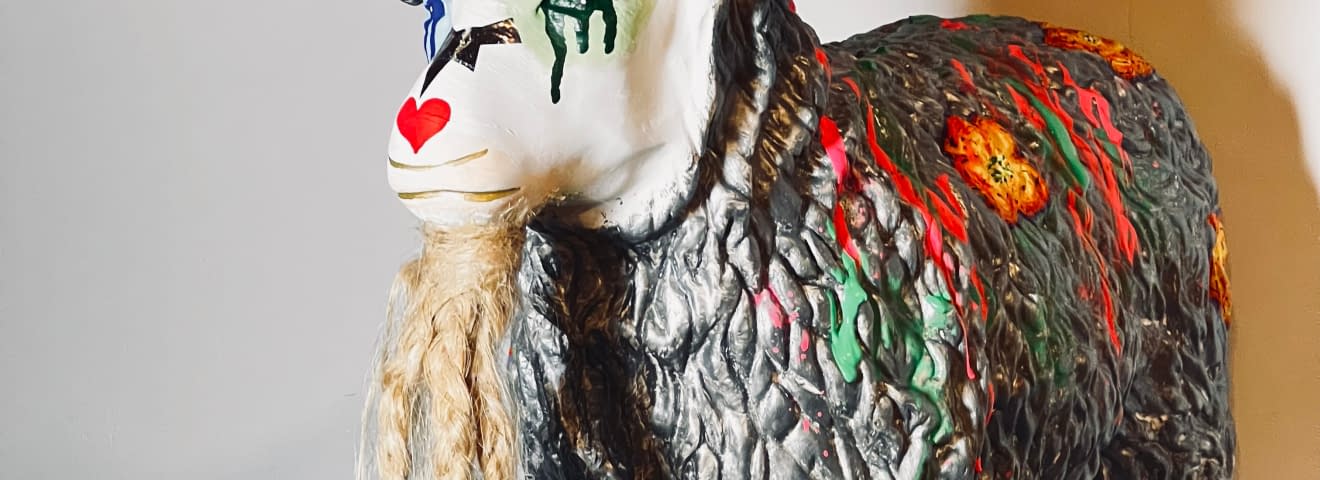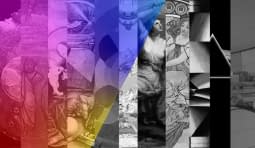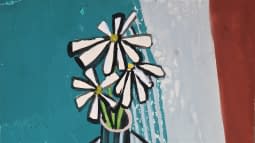The ram – a symbol of power (of creation) and resilience (Part 3)
Part 3: The ram as a sacrificial animal
To continue the theme of the sacrificial animal elaborated in the second part, it is interesting to observe that animals have also been and still are used as «objects» for the human spectacle, for example in theatre. Here, too, animals are alive or, more ethically justifiable, symbolically or sculpturally embodied on stage. Through this staging of animals, parallels to the aforementioned ritual or sacrificial animal can be seen, because there too their symbolic meaning played an important role for «ritual performances and festivals». The sacrificial animal thereby placed itself, whether voluntarily or not, in service for the good of the community. So, could it be argued that the use of animals for human needs lives on today in the form of theatre and art? A prime example in this regard is Joseph Beuy's art action «How to explain the pictures to the dead rabbit» from 1965. And in an even more extreme form, this was demonstrated by the Viennese artist Hermann Nitsch, who actually slaughtered animals as part of his art, including sheep. He caused a shocking stir by concretely demonstrating the act of killing in a society that had distanced itself from slaughter as part of the consumption of animals, which takes place in slaughterhouses away from the public. The parallels are also evident in the concept of theatre itself. «Tragedy» is composed of the Greek words «tragos», meaning goat, and «ode», meaning song. This points to a male animal that was sacrificed during a play (Dionysus' festival) and while singing (cf. Roters 2022, 31). During these ritual processions, people were also dressed in masks and buckskins. The participants were thus offered something visual. The visual plays an important role, especially in the identification with the animal, if we think back to Derrida's philosophy. So, do we always see ourselves in the animal? As Derrida said, «There is no culture without the cult of the ancestors, without the ritualisation of mourning and sacrifice [...]" (1998, 77). So, we need the confrontation with death in order to become aware of our present state and the future and to develop ourselves. In this process, death is related to mourning. Existence can be experienced through mourning. It is thus an attempt to take possession of death, this otherwise inaccessible state, according to Tasheva: «death for the sake of life, death as an absolute affirmation of existence» (2009, 293). The selfless sacrifice becomes an object of exchange to get in touch with gods, ancestors and spirits and to receive their favour. The sacrifice is thus excluded from the world of the living, but at the same time becomes sacred. In doing so, man has the hope of receiving something in return (cf. Tasheva 2009, 293). Through sacrifice, other sacrifices are to be prevented. Together, then, sacralisation promised trust and confidence. The dead have access to this sacred space and become sacred themselves in this cultural context. Death, however, remains silent and unrequited despite the ritual, the sacrifice. The unrequitedness lives on only through faith. These acts were thus incorporated into social, repetitive practices and became something common (cf. Tasheva 2009, 293) So, have we at art24 staged a modern, less dramatic, less sad (sacrificial) ritual? Can this be seen as a positive ritual? A ritual that connects and celebrates life through action in time and space. A sacrifice that has an exchange value other than death?
The art24 Charity Event and the transformation of the white rams
Modern and contemporary art dealing with animals has already been briefly discussed. Of course, there are many other exciting works of art that cover different questions and forms of aesthetics. The occasion for this examination of the animal «ram» was a charity event organised by art24. Here, 9 ram sculptures in a specific space became the object of artistic reflection for 9 artists. The animals became part of an individual design and transformation process of the respective artist. The innocent-looking, white-primed animals and the surface texture of their fur were given a new appearance and at the same time became part of a «live performance». The animal sculptures were integrated into a «ritual performance practice», so to speak, and became a spectacle through which attention was to be drawn to the art24.world art platform and the artists. In a similar way, we still see this today in the theatre and, in a related sense, in zoos. Similar practices took place in the Roman Empire, where animals, including sheep, were used for show and representation in a public setting, in cages, in processions, staged hunts and games. They were thus objects of hunting and display in these rituals, in which the subsequent ritual killing was often the focus of the event. As already experienced, this was about the borderline experience between life and death. Fortunately, only three-dimensional copies of rams were used at the art24 charity event and no living animals. The killing, the mourning, the fear of death, the silence of death, all this is thus omitted. The common and the individual of this process of creation and contemplation stand side by side in the foreground, as does the experience of transformation towards something new and positive, but also an intensive examination of the present, which the artists transferred to the rams. Their thoughts are thus transmitted to the audience. These characteristics all point to a future that is co-determined by the past, but the different outcomes also open up options and possibilities for negotiation.
This said, the ram today symbolises character traits that no longer necessarily have to be tied to religious dogmas, but which have been shaped and influenced by this past. Today, the ram symbolises strength, willpower, combativeness, optimism, resilience and resistance, which also gives the animal «agency». Although animals today are still seen as things and often as human property, and the treatment of them has taken on dramatic consequences, there is accordingly also much discussion about animal rights, with the aim of reinterpreting them for animal welfare. Here, too, parallels to art24 can be found. For the boundaries of art and culture are also being reinterpreted and discussed in the digital age, new and divergent forms of opinion-forming bodies and the art market are being tested and questioned. Artists should benefit from art24, network, create something together through their individual contributions and at the same time make other people think or bring joy. Art creates possibilities. Art thus has similar characteristics to those historically assigned by humans to the sheep, which feels comfortable in the herd, or the ram, which in prehistoric cultures was considered «potent», able to produce something and resistant. So art24 also hopes that the 9 newly created rams symbolise this attribution. In doing so, we also think back to the elaborated shamanistic meaning of animals. In the search for distinction from others through the question «who am I, compared to... », the creators of art help to form art24. The animal acts as a guide, as a possibility of borderline experience and identification figure. The fur structure of the sculptures alone, which is reminiscent of cave structures, is reminiscent of this fusion of animal and human, which the artists probably came closest to as «shamans» and thus as transmitters. In this way they transport these qualities out into the world. And the sacrificial component in the ram can also be reinterpreted. For the proceeds from the auction of the rams at the end were all donated to institutions chosen by the artists. So, we can still speak of a sacrificial offering, which everyone hopes will have a positive influence without causing suffering. Thus, the ram is indeed a resilient animal that acquires a new symbolic meaning for us humans and can thus transmit values.
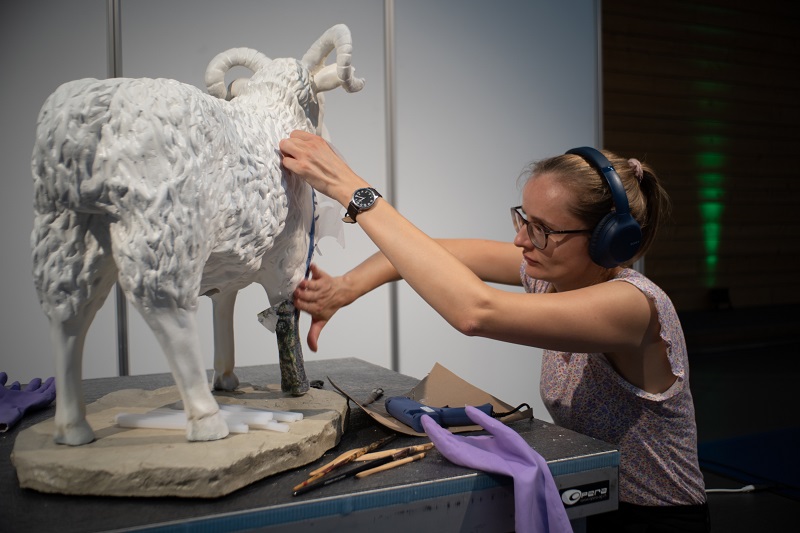
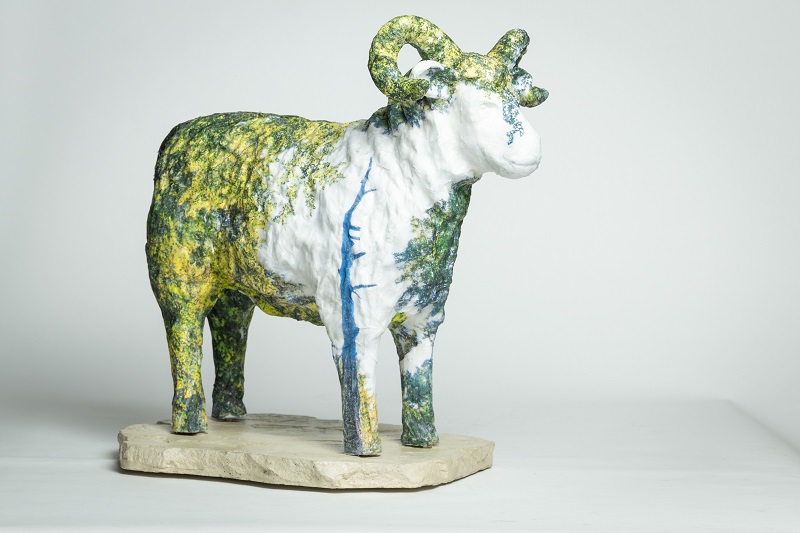
picture credit:
Image 5_Artist Helen Eggenschwiler working on her ram «Growing, never to stop» for the art24 charity event «Art for Charity», the proceeds of which went to «Gassenarbeit Luzern». Photo: art24.world.
Image 6_The ram by artist Helen Eggenschwiler «Growing, never to stop», the proceeds of which went to« Gassenarbeit Luzern». Photo: art24.world.
Cover: Ram by Merges Visible. Milk the ram, 2022. Photo: art24.world.
